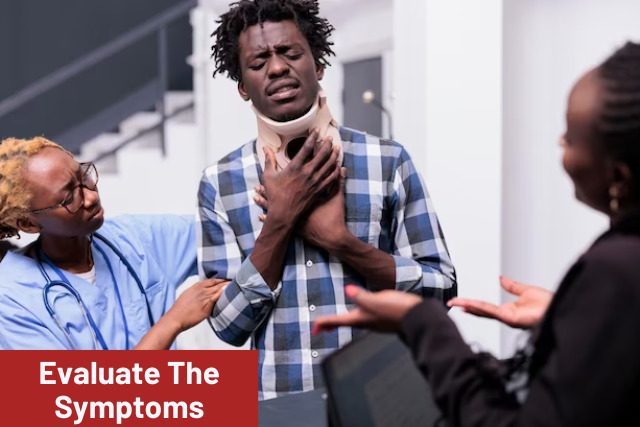
Injury: How To Recognize | Evaluate The Symptoms- Getting hurt while just minding your business can be a hassle for anyone. Even something as minor as a headache can throw you off your groove.
When that pain starts to bother you, how do you get rid of it? Aspirin won’t always help. You can apply first-aid, but this only serves as immediate care until proper medical treatment is available for your injury.
Every Injury has a specific remedy that’s meant to heal it effectively. Choosing the wrong one can bring long-lasting negative effects to your body if you’re not careful. So, you need to know which treatment works best for what. Listed below are ways on how to do just that.
Injury: How To Recognize | Evaluate The Symptoms
Recognize What Your Injury Is
Before anything else, you need to know what’s causing you pain. It’s the first step to determining the proper treatment for your injury. Common injuries include but are not limited to the following:
- Sprains
- Strains
- Burns
- Bites
- Fractures
- Dislocations
Injury: How To Recognize | Evaluate The Symptoms- Take a closer look at each of these common injuries below.
- Sprains and strains: Sprains and strains sound the same but are quite different. Yes, they have similar symptoms like swelling and limited motion on the affected joints. However, sprains are torn or overstretched ligaments that are usually found on your ankles.
Meanwhile, strains have the same traits, but on the tendons. These can be found in areas like your lower back or hamstrings.
- Burns: Burns are measured in degrees based on how severe it is. These can go from the first-degree (surface-level burns) to the fourth-degree (critical burns that may reach bone). Often, these should receive medical care immediately regardless of the degree.
- Bites: Bites are caused by tiny insects or large animals. Like burns, these need treatment as soon as possible. Even small ones like insect and snake bites can be fatal if not given quick and proper attention.
- Fractures: Fractures are breaks in the bone. They have different types like hairline fractures and compression fractures, for example. Some breakthrough the skin, while others are harder to find. You can spot internal fractures if you experience swelling, bruising, and immobility on the affected area.
- Dislocations: Dislocations are joint injuries. The area where two or more bones meet is where these injuries can be located. Common points include the elbows, knees, shoulders, and hips.
Once you’ve recognized your injury, you can start thinking about prospective medical care for it. For muscle and joint injuries, physiotherapy clinics like Brampton physiotherapy clinic White Pine Health may alleviate your pain after some sessions. On the other hand, doctors from your local hospital may treat burns and bites. The same goes for fractures and dislocations.
Injury: How To Recognize | Evaluate The Symptoms- Having a general medical professional in mind may hasten the process of finding treatment. Keep in mind that immediate action is essential. That’s because it could potentially lessen the risk of added symptoms or long-term complications.
Evaluate The Symptoms OF Injury

Now that you know what your injury is, you need to observe it. Different injuries will manifest different symptoms. Certain symptoms may also require specific treatment/s, so make sure to identify everything you can see and feel.
Below are the symptoms that common injuries usually manifest and their recommended treatments:
- Sprains and strains: Sprains and strains may share similarities. What usually happens, though, is that a sprain has bruises while a strain has muscle spasms. If believed to be mild, both could be treated with the RICE technique. RICE stands for Rest, Ice, Compression, and Elevation. However, if these turn out to be severe, you may require surgery.
- Burns: A burn’s cure will depend on its degree. Third-degree burns may not trigger any immediate pain as these could have already damaged the nerve endings. Second-degree burns may exhibit blisters on the skin. While first-degree burns only show on the outermost layer of your skin, like a sunburn. They’re not as severe as the first two but may irritate you if ignored. Depending on the severity of the burn, you may be treated with fluids, ointments, or skin grafts.

- Bites: If you’ve been bitten, try to find out and remember what bit you. Knowledge of this is crucial for the treatment process. Mammals may carry with them rabies through their bite. On the other hand, insect stings may cause allergies to certain individuals, resulting in hives or rashes.It’s also necessary to know the kind of venomous snake if you’re bitten by one. Responders will depend on this information to know which antivenom to use.
- Fractures: As mentioned previously, fractures can either break the skin or stay inside. These may display symptoms like discoloration or protrusions aside from swelling and pain. For some severe cases, you may experience nausea and dizziness. Bleeding is also possible for open fractures.
- Dislocations: Treatment for dislocations will depend on where it is. Take, for example, a hip dislocation. Since this is near the groin area, doctors may give careful thought to what should be done. Dislocations could be put back in place manually, sometimes while the patient is under light sedatives. In other cases, like severe sprains and strains, these are tended to via surgery.
Superficial wounds could be deemed non-fatal. Even if you happen to have these, keep in mind that every piece of information is important. Disregarding mild or moderate symptoms may even worsen your injury.
Choose A Medical Professional Based On Your Observations
Choosing the right doctor ought to be the same as selecting the proper treatment for your injury. As long as you understand what’s wrong, narrowing down options for help will be easier.
Here are the different medical professionals that could help you after sustaining an injury:
- Chiropractors: Chiropractors and physical therapists aid in treating muscle injuries. After examining your situation, they’ll prescribe stability measures and exercises to prevent the damage from happening again. They may work in tandem with general practitioners.
- Dermatologists: Aside from your designated physician, a dermatologist may help in your treatment process of burns. It potentially includes concerns like third to fourth-degree burns.
- General physicians: Most general doctors can handle minor bites from insects. They could prescribe you an ointment or antibiotic you’ll need to apply regularly at home. For larger bites and snake bites, they may direct you to the emergency room.
- Orthopedists: Orthopedic doctors and surgeons are your safest bet for fractures and dislocations. After the initial treatment, they could advise you to seek aid from a chiropractor to treat the muscles further.
Don’t forget to inform your doctor of every symptom you’re experiencing. For them to provide a correct prognosis, they’ll require as much information as possible. It’s true even for concerns that you’re not sure of. Tell them everything you know for them to make the correct diagnosis.
Conclusion:
Understanding your injury and its symptoms is vital in determining the right treatment you need. Whichever doctor you choose, be sure to listen to them well and follow their advice.
Also, keep in mind that treatment usually isn’t a one-day affair. In the end, you and your doctor should have the same goal for you to heal and recover faster from injury.
